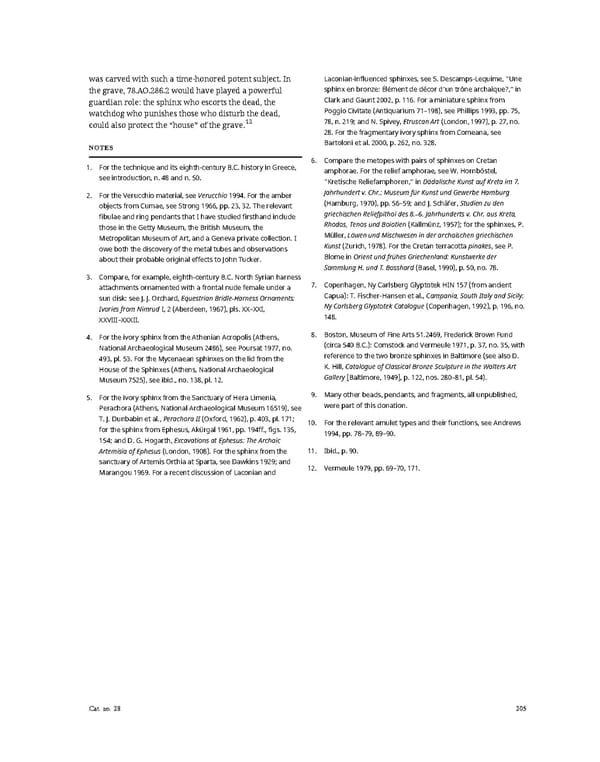was carved with such a time-honored potent subject. In Laconian-influenced sphinxes, see S. Descamps-Lequime, “Une the grave, 78.AO.286.2 would have played a powerful sphinx en bronze: Élément de décor d’un trône archaïque?,” in guardian role: the sphinx who escorts the dead, the Clark and Gaunt 2002, p. 116. For a miniature sphinx from watchdog who punishes those who disturb the dead, Poggio Civitate (Antiquarium 71–198), see Phillips 1993, pp. 75, could also protect the “house” of the grave.12 78, n. 219; and N. Spivey, Etruscan Art (London, 1997), p. 27, no. 28. For the fragmentary ivory sphinx from Comeana, see NOTES Bartoloni et al. 2000, p. 262, no. 328. 1. For the technique and its eighth-century B.C. history in Greece, 6. Compare the metopes with pairs of sphinxes on Cretan see introduction, n. 48 and n. 50. amphorae. For the relief amphorae, see W. Hornböstel, “Kretische Reliefamphoren,” in Dädalische Kunst auf Kreta im 7. 2. For the Verucchio material, see Verucchio 1994. For the amber Jahrhundert v. Chr.: Museum für Kunst und Gewerbe Hamburg objects from Cumae, see Strong 1966, pp. 23, 32. The relevant (Hamburg, 1970), pp. 56–59; and J. Schäfer, Studien zu den fibulae and ring pendants that I have studied firsthand include griechischen Reliefpithoi des 8.–6. Jahrhunderts v. Chr. aus Kreta, those in the Getty Museum, the British Museum, the Rhodos, Tenos und Boiotien (Kallmünz, 1957); for the sphinxes, P. Metropolitan Museum of Art, and a Geneva private collection. I Müller, Löwen und Mischwesen in der archaischen griechischen owe both the discovery of the metal tubes and observations Kunst (Zurich, 1978). For the Cretan terracotta pinakes, see P. about their probable original effects to John Tucker. Blome in Orient und frühes Griechenland: Kunstwerke der Sammlung H. und T. Bosshard (Basel, 1990), p. 50, no. 78. 3. Compare, for example, eighth-century B.C. North Syrian harness attachments ornamented with a frontal nude female under a 7. Copenhagen, Ny Carlsberg Glyptotek HIN 157 (from ancient sun disk: see J. J. Orchard, Equestrian Bridle-Harness Ornaments: Capua): T. Fischer-Hansen et al., Campania, South Italy and Sicily: Ivories from Nimrud I, 2 (Aberdeen, 1967), pls. XX–XXI, Ny Carlsberg Glyptotek Catalogue (Copenhagen, 1992), p. 196, no. XXVIII–XXXII. 148. 4. For the ivory sphinx from the Athenian Acropolis (Athens, 8. Boston, Museum of Fine Arts 51.2469, Frederick Brown Fund National Archaeological Museum 2486), see Poursat 1977, no. (circa 540 B.C.): Comstock and Vermeule 1971, p. 37, no. 35, with 493, pl. 53. For the Mycenaean sphinxes on the lid from the reference to the two bronze sphinxes in Baltimore (see also D. House of the Sphinxes (Athens, National Archaeological K. Hill, Catalogue of Classical Bronze Sculpture in the Walters Art Museum 7525), see ibid., no. 138, pl. 12. Gallery [Baltimore, 1949], p. 122, nos. 280–81, pl. 54). 5. For the ivory sphinx from the Sanctuary of Hera Limenia, 9. Many other beads, pendants, and fragments, all unpublished, Perachora (Athens, National Archaeological Museum 16519), see were part of this donation. T. J. Dunbabin et al., Perachora II (Oxford, 1962), p. 403, pl. 171; 10. For the relevant amulet types and their functions, see Andrews for the sphinx from Ephesus, Akürgal 1961, pp. 194ff., figs. 135, 1994, pp. 78–79, 89–90. 154; and D. G. Hogarth, Excavations at Ephesus: The Archaic Artemisia of Ephesus (London, 1908). For the sphinx from the 11. Ibid., p. 90. sanctuary of Artemis Orthia at Sparta, see Dawkins 1929; and 12. Vermeule 1979, pp. 69–70, 171. Marangou 1969. For a recent discussion of Laconian and Cat. no. 28 205
 Ancient Carved Ambers in the J. Paul Getty Museum Page 214 Page 216
Ancient Carved Ambers in the J. Paul Getty Museum Page 214 Page 216